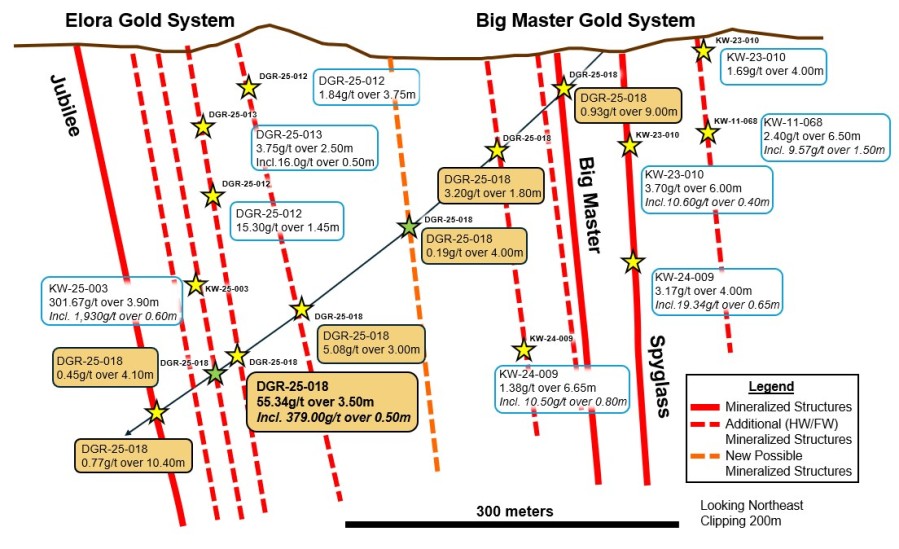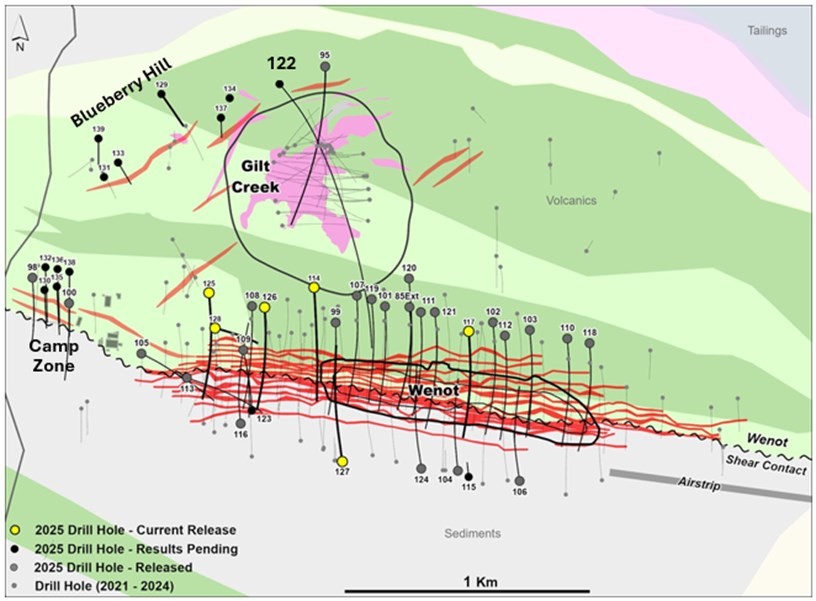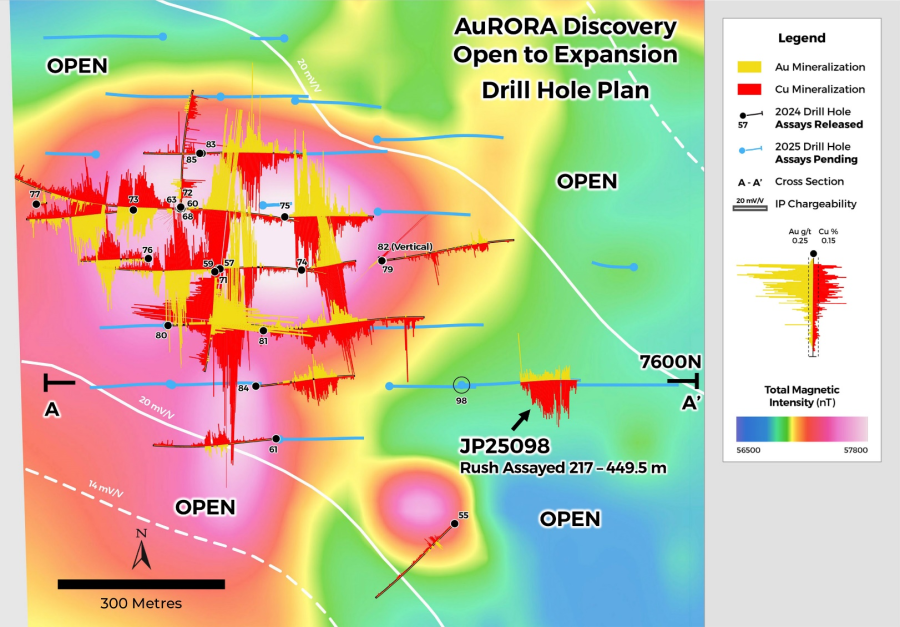Toronto, Ontario--(Newsfile Corp. - April 4, 2017) - Pancontinental Gold Corporation (TSXV: PUC) ("Pancon Gold," "Pancon" or the "Company") is pleased to report positive gold assay results from the initial stage of drilling at its 100%-owned Jefferson Gold Project ("Jefferson Project") in South Carolina, USA. A total of six holes (JEF-104 to JEF-109) and 912 meters were drilled between November 2016 and March 2017, using a single shift during daylight hours. The drill program is managed by Palmetto Mining Corporation, Pancon's wholly owned subsidiary (see Figure 1).
Highlights (see Table 1)
-
5 out of 6 holes intersected anomalous gold grades indicative of a focused gold system;
-
JEF-108 intersected 22.9 m averaging 1.3 g/t, including 8.5 m of 1.8 g/t;
-
JEF-109 intersected 12.2 m of 1.55 g/t; and
-
Drilling verified a northwest trending mineralized zone previously unrecognized.
Pancon Gold President and CEO Rick Mark stated: "These results have achieved our first milestone, which is to demonstrate that our flagship Jefferson Project's first gold system is substantial in terms of its width. Our team is beginning to understand this system so that it can be vectored. We are encouraged by the initial drill program, and now have valuable data and informed analysis to guide our next stage of exploration at Jefferson, as well as acquisition of new targets elsewhere in this historically gold rich and underexplored Carolina Gold Belt."
Table 1: results from drilling at Anomaly A, Jefferson Gold Project (see Figures 2 and 3)
All intercepts quoted are apparent thickness. All widths reported are core intervals and not true width.
Strategic Significance of Results to Date
Pancon Gold believes our initial stage of drilling at our Jefferson Project has been quite positive for grades and thickness of gold, especially in the fifth and sixth holes (JEF-108 and JEF-109), which were drilled in a new orientation. Initial results are from the Anomaly A target, where the Company has focused on defining controls on mineralization and understanding the trend of mineralization in a poorly exposed gold system partially covered by sand. These results provide useful data and knowledge further to 2011 drilling at Anomaly A by a prior company (as detailed in Pancon's news release of May 25, 2016, available on www.pancongold.com).
Gold mineralization at the Jefferson Project is controlled by intersecting trends of structure and folding. The core from Jefferson is hosted in felsic volcanic rock, which in the mineralized areas is commonly described as fragmental tuff or breccia near sedimentary contacts as seen in holes 104 and 105. Typically, better gold values are in more deformed or sheared altered host rock. This resembles the Haile gold mine, located less than 10 kilometres to the southwest of the Jefferson Project, where "the deposits are primarily volcanic-rock hosted, massive sulfide, and disseminated gold-sulfide deposits, which formed along the stratigraphic boundary between the metavolcanics and overlying metasedimentary rocks (Mobley and others, 2014, Economic Geology, v. 109, pp. 1863)."
The Jefferson Project is bounded on the west by a high sulfidation gold system at the adjacent Brewer gold mine site. Historic mining at Brewer began in 1828 and operated intermittently until 1995. From 1987-1995, the Brewer Gold Company mined over 12 million tons of ore and waste rock from several open pits (personal knowledge of the Company's Qualified Person and United States Environmental Protection Agency: https://cumulis.epa.gov/supercpad/cursites/csitinfo.cfm?id=0405550).
Dr. Dennis LaPoint, PhD, LGeo., the Company's Vice-President of Exploration and Qualified Person (QP) has personally explored and examined the Haile and Ridgeway mine areas since the 1980s and notes that the age, deformation and lithologies identified at the Jefferson Project are comparable to host rocks at the Haile gold mine, as well as at the former Ridgeway gold mine located 55 kilometres southwest of Jefferson. Mr. LaPoint was actively exploring near Ridgeway when it was discovered and developed in the 1980s. The Ridgeway mine was discovered in a region with minimal historic prospects that lies near the edge of sand cover, like at Haile and at Jefferson (LaPoint, D.J., 1995, SEG Guidebook, pp. 21-52).
Pancon believes that the multiple styles of mineralization at its 100%-owned Jefferson Project greatly enhance the value potential of the Project. Drilling at Jefferson will resume following thorough review of the data to date, geophysical surveys, and potential new land acquisition along the Carolina Gold Belt.
Technical Insights from Recent Drill Program
A strong and distinctive chloritic alteration is commonly associated with the strongest mineralization. Silification and a higher percentage of pyrite correlate with gold in some instances. There is more than one style of mineralization and more than one generation of pyrite. Mineralization often follows a steep west-southwest foliation as well zones of shearing, which may follow a more northwest orientation. Higher grades are often associated with breccia zones that are deformed.
Within one small area of drilling at the Jefferson Project there are multiple mineralization styles and orientations. For instance, although hole JEF-105 intersected little gold, it is very important geologically and structurally, as it suggests untested potential. The initial part of hole JEF-105 was in banded pyritic sediments that are sericitized like those encountered at the Haile and Ridgeway gold mines.
Table 2: Results from drilling at Anomaly A, Jefferson Gold Project
Figure 1: Jefferson Gold Project managed by Palmetto Mining Corporation
Figure 2: Results from drilling at Anomaly A, Jefferson Gold Project
Figure 3: Results from drilling at Anomaly A, Jefferson Gold Project
Qualified Person and Sample Protocol
Dr. Dennis LaPoint, PhD, LGeo, is a Qualified Person (QP) under National Instrument 43-101 "Standards of Disclosure for Mineral Projects" and has approved the technical information contained in this news release. Dr. LaPoint is not independent of Pancon Gold, as he is Pancon's Vice-President of Exploration. Dr. LaPoint has verified all the technical data in this release.
Samples were shipped to ALS Chemex in Arizona by truck for preparation and then to ALS in Vancouver for fire assay gold analysis and four acid digestion 33 element ICP-AES analysis. Standard QA/QC procedures are followed including, blanks, duplicates and standards.
About Pancon Gold
Pancontinental Gold Corporation (www.pancongold.com) is a Canadian-based mining company focused on the exploration and development of its 100%-owned Jefferson Gold Project in South Carolina, USA, and on acquiring additional prospective properties. The Company's shares are listed on the TSX Venture Exchange, trading under the symbol PUC. In 2015, Pancon sold its interest in its Australian rare earth element (REE) and uranium properties, formerly held through a joint venture, and retains a 1% gross overriding royalty on 100% of future production. Pancon's exploration objective is to discover and define a gold deposit similar to the Haile mine deposit, and the Board is optimistic that the Company's flagship Jefferson Project has the potential to provide that opportunity.





